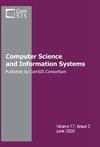Inverse halftoning based on sparse representation with boosted dictionary
IF 1.2
4区 计算机科学
Q4 COMPUTER SCIENCE, INFORMATION SYSTEMS
引用次数: 0
Abstract
Halftone image is widely used in printing and scanning equipment. It is significant for the halftone image to be preserved and processed. For the different resolution of the display devices, the processing and displaying of halftone image are faced with great challenges, such as Moore pattern and image blur ring. The inverse halftone technique is required to remove the halftone screen. In this paper, we propose an inverse halftone algorithm based on sparse representation with the dictionary learned by two steps: deconvolution and sparse optimization in the transform domain to remove the noise. The main contributions of this paper include three aspects: first, we analysis the denoising effects for different training sets and the dictionary; Then we propose the denoising algorithm through adaptively learning the dictionary, which iteratively remove the noise of the training set and improve the dictionary; Then the inverse halftone algorithm is proposed. Finally, we verify that the noise level in the error diffusion linear model is fixed, and the noise level is only related to the diffusion operator. Experimental results show that the proposed algorithm has better PSNR and visual performance than state-of-the-art methods. The codes and constructed models are available at https://github.com/juneryoung2022/IH-WNNM.基于增强字典稀疏表示的逆半调
半色调图像广泛应用于印刷和扫描设备中。对半色调图像的保存和处理具有重要意义。由于显示设备的分辨率不同,半色调图像的处理和显示面临着摩尔模式和图像模糊环等巨大的挑战。反半色调技术是用来去除半色调网版的。本文提出了一种基于稀疏表示的反半色调算法,该算法通过变换域的反卷积和稀疏优化两步学习字典来去除噪声。本文的主要贡献包括三个方面:首先,我们分析了不同训练集和字典的去噪效果;然后提出了一种基于自适应学习字典的去噪算法,迭代去除训练集的噪声,改进字典;然后提出了反半色调算法。最后,我们验证了误差扩散线性模型中的噪声电平是固定的,并且噪声电平仅与扩散算子有关。实验结果表明,该算法具有较好的PSNR和视觉性能。代码和构建的模型可在https://github.com/juneryoung2022/IH-WNNM上获得。
本文章由计算机程序翻译,如有差异,请以英文原文为准。
求助全文
约1分钟内获得全文
求助全文
来源期刊

Computer Science and Information Systems
COMPUTER SCIENCE, INFORMATION SYSTEMS-COMPUTER SCIENCE, SOFTWARE ENGINEERING
CiteScore
2.30
自引率
21.40%
发文量
76
审稿时长
7.5 months
期刊介绍:
About the journal
Home page
Contact information
Aims and scope
Indexing information
Editorial policies
ComSIS consortium
Journal boards
Managing board
For authors
Information for contributors
Paper submission
Article submission through OJS
Copyright transfer form
Download section
For readers
Forthcoming articles
Current issue
Archive
Subscription
For reviewers
View and review submissions
News
Journal''s Facebook page
Call for special issue
New issue notification
Aims and scope
Computer Science and Information Systems (ComSIS) is an international refereed journal, published in Serbia. The objective of ComSIS is to communicate important research and development results in the areas of computer science, software engineering, and information systems.
 求助内容:
求助内容: 应助结果提醒方式:
应助结果提醒方式:


